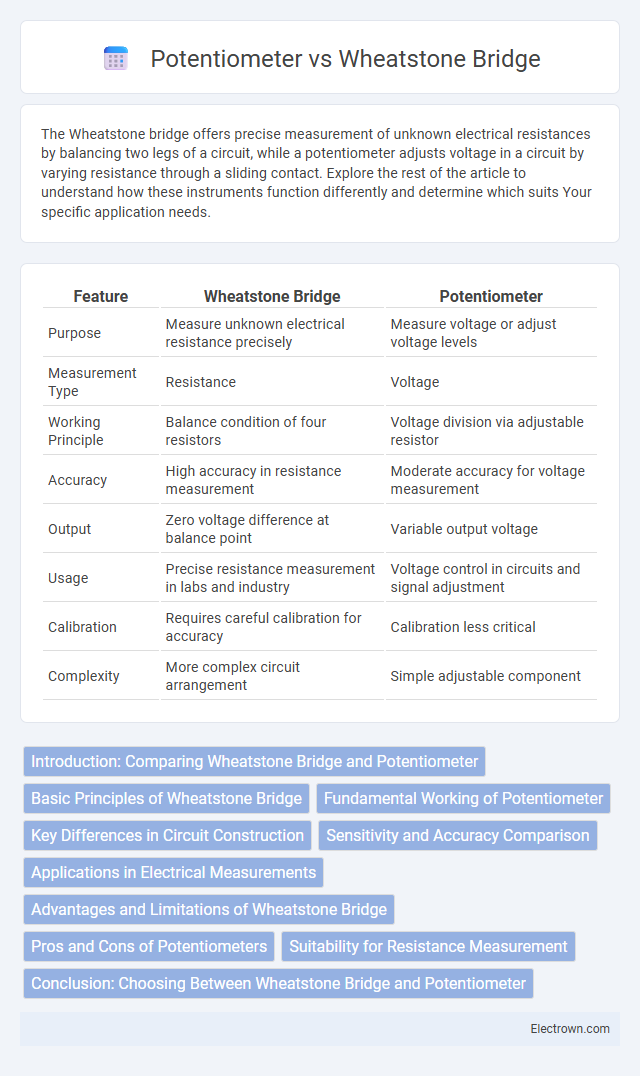The Wheatstone bridge offers precise measurement of unknown electrical resistances by balancing two legs of a circuit, while a potentiometer adjusts voltage in a circuit by varying resistance through a sliding contact. Explore the rest of the article to understand how these instruments function differently and determine which suits Your specific application needs.
Table of Comparison
| Feature | Wheatstone Bridge | Potentiometer |
|---|---|---|
| Purpose | Measure unknown electrical resistance precisely | Measure voltage or adjust voltage levels |
| Measurement Type | Resistance | Voltage |
| Working Principle | Balance condition of four resistors | Voltage division via adjustable resistor |
| Accuracy | High accuracy in resistance measurement | Moderate accuracy for voltage measurement |
| Output | Zero voltage difference at balance point | Variable output voltage |
| Usage | Precise resistance measurement in labs and industry | Voltage control in circuits and signal adjustment |
| Calibration | Requires careful calibration for accuracy | Calibration less critical |
| Complexity | More complex circuit arrangement | Simple adjustable component |
Introduction: Comparing Wheatstone Bridge and Potentiometer
Wheatstone Bridge and Potentiometer are precision instruments used for measuring electrical resistance with distinct operational principles. Wheatstone Bridge offers high accuracy by balancing four resistors to detect minute changes, ideal for sensor applications and calibration tasks. Your selection between these devices depends on the required measurement accuracy and the specific application context in electrical circuit analysis or testing.
Basic Principles of Wheatstone Bridge
The Wheatstone bridge operates on the principle of null deflection to measure unknown electrical resistance by balancing two legs of a bridge circuit. It consists of four resistors arranged in a diamond shape, where the ratio of two known resistors balances the unknown resistor, allowing precise calculation through the equation R1/R2 = R3/Rx. This method provides high accuracy in resistance measurement, minimizing the effects of fluctuations in voltage and current during experiments or industrial applications.
Fundamental Working of Potentiometer
The fundamental working of a potentiometer involves measuring an unknown voltage by comparing it to a known reference voltage through a variable resistive element. Unlike the Wheatstone bridge, which balances resistances to determine an unknown value, the potentiometer adjusts the slider along a resistive wire until the galvanometer shows zero deflection, indicating the measured voltage equals the reference voltage. This null measurement method ensures high accuracy by eliminating errors caused by the measuring device's internal resistance.
Key Differences in Circuit Construction
The Wheatstone bridge consists of four resistors arranged in a diamond shape with a galvanometer connected between two opposite nodes, allowing precise measurement of an unknown resistance by balancing the bridge. In contrast, a potentiometer involves a single variable resistor with a sliding contact that adjusts voltage division, enabling direct measurement of voltage or comparison of EMFs without drawing current from the measured circuit. The Wheatstone bridge requires careful balancing of all four resistors, while the potentiometer depends on the position of the wiper to achieve voltage null conditions, making their circuit constructions fundamentally different in complexity and application.
Sensitivity and Accuracy Comparison
Wheatstone bridges provide high sensitivity by measuring minute changes in resistance, making them ideal for precise sensor applications. Potentiometers offer adjustable sensitivity but generally have lower accuracy due to mechanical limitations and contact resistance. Your choice depends on whether fine measurement precision or variable control is more critical for the application.
Applications in Electrical Measurements
Wheatstone bridges are widely used in precise resistance measurements, strain gauge instrumentation, and sensor calibration due to their accuracy in detecting small changes in resistance. Potentiometers serve as variable resistors or voltage dividers, commonly applied in adjusting signal levels, measuring voltages, and in position sensing devices. Both instruments are integral in electrical measurements, with Wheatstone bridges preferred for high-precision applications and potentiometers favored for adjustable and real-time voltage measurements.
Advantages and Limitations of Wheatstone Bridge
The Wheatstone bridge offers high accuracy and sensitivity for measuring unknown resistances, making it ideal for precise electrical measurements and sensor calibrations. It provides a balanced condition that reduces measurement errors caused by voltage fluctuations but requires careful manual adjustment to achieve this balance, which can be time-consuming. This method is less suitable for dynamic or rapid measurements compared to potentiometers, which allow continuous and quicker resistance variation control, offering greater versatility in certain applications.
Pros and Cons of Potentiometers
Potentiometers offer cost-effective and simple solutions for measuring voltage or adjusting resistance, making them ideal for calibration and tuning applications in various electronic devices. Their main drawbacks include mechanical wear over time, limited precision compared to Wheatstone bridges, and susceptibility to noise and environmental factors such as temperature and humidity. You should consider these factors when choosing potentiometers for applications requiring stable and highly accurate measurements.
Suitability for Resistance Measurement
The Wheatstone bridge is highly suitable for precise resistance measurement, especially for low to medium resistance values, due to its balanced circuit providing accurate resistance comparison. Potentiometers excel in measuring higher resistance ranges and allow continuous variation, making them ideal for calibration and tuning applications. Both instruments offer high sensitivity, but Wheatstone bridges are preferred in laboratory settings for exact resistance determination, while potentiometers are favored for practical adjustments in circuits.
Conclusion: Choosing Between Wheatstone Bridge and Potentiometer
Choosing between a Wheatstone bridge and a potentiometer depends on measurement precision and application type. The Wheatstone bridge excels in accurate resistance measurement and sensor applications, while the potentiometer offers simple, adjustable voltage control ideal for calibration or tuning. Your selection should prioritize the required sensitivity, complexity, and real-time adjustment capabilities for optimal performance.
Wheatstone bridge vs Potentiometer Infographic

 electrown.com
electrown.com